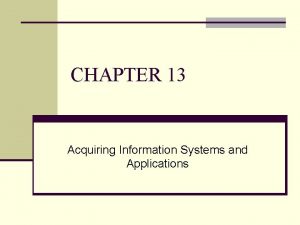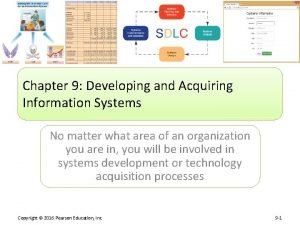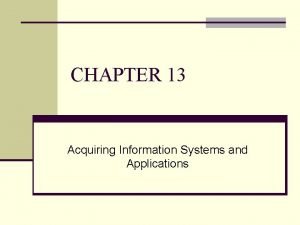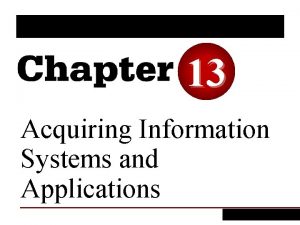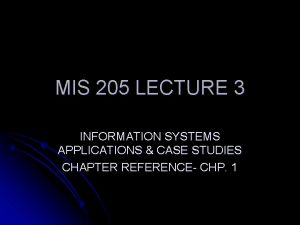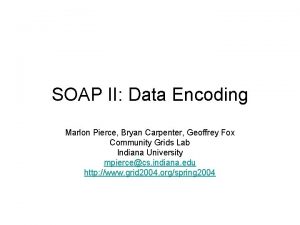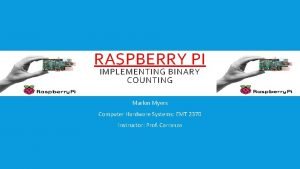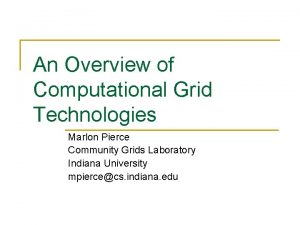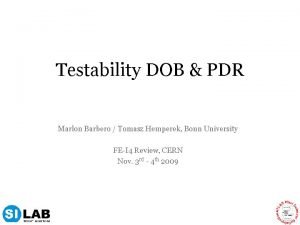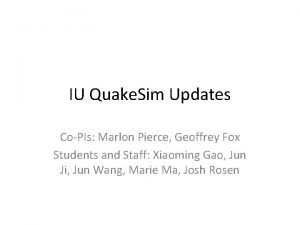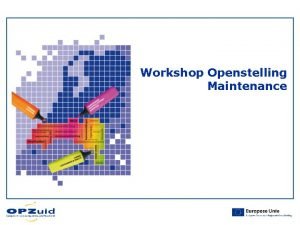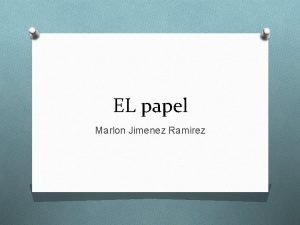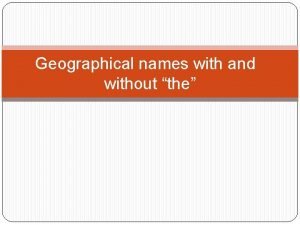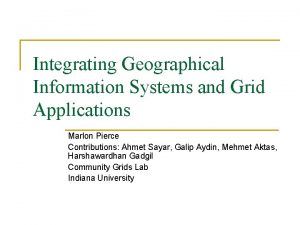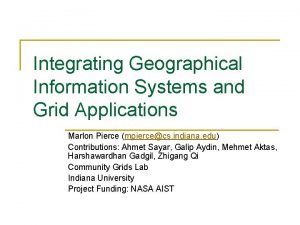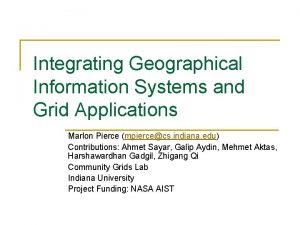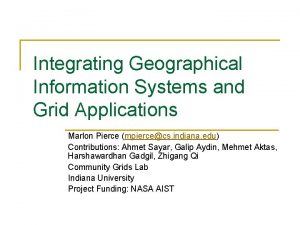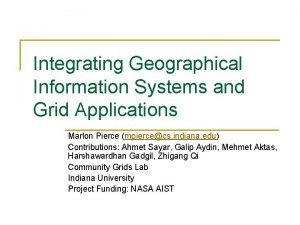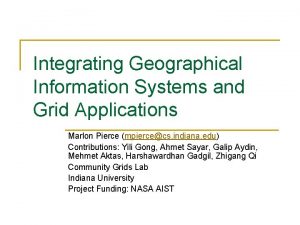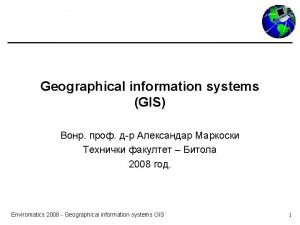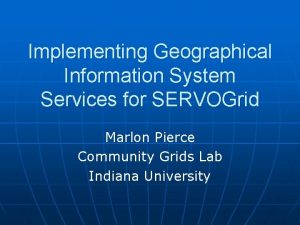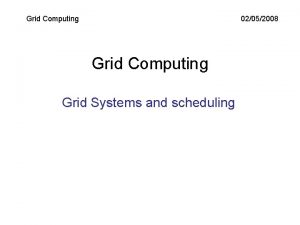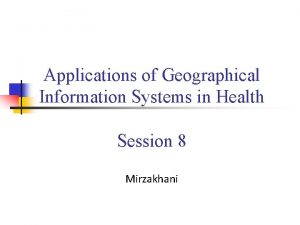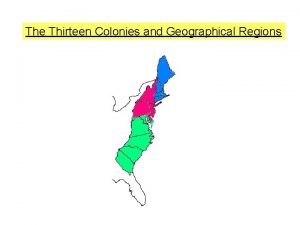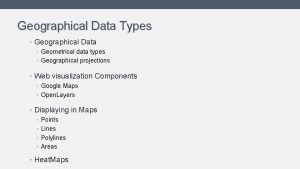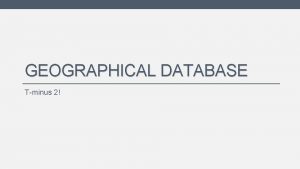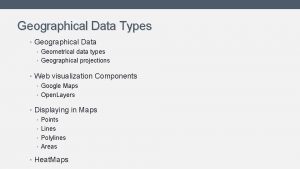Integrating Geographical Information Systems and Grid Applications Marlon




















- Slides: 20

Integrating Geographical Information Systems and Grid Applications Marlon Pierce (mpierce@cs. indiana. edu) Contributions: Ahmet Sayar, Galip Aydin, Mehmet Aktas, Harshawardhan Gadgil Community Grids Lab Indiana University

Geographical Information Systems and Grid Applications n n Pattern Informatics q Earthquake forecasting code developed by Prof. John Rundle (UC Davis) and collaborators. q Uses seismic archives as input Regularized Dynamic Annealing Hidden Markov Method (RDAHMM) q Time series analysis code by Dr. Robert Granat (JPL). q Can be applied to GPS and seismic archives. q Can be applied to real-time data. Geo. FEST q Finite element method code developed by Dr. Jay Parker (JPL) and Prof. Greg Lyzenga (JPL/Harvey Mudd College) q Uses fault models as input. Virtual California q Prof. Rundle’s UC-Davis group q Used for simulating time evolution of fault systems using fault and fault friction models.

n Pattern Informatics in a Grid Environment PI in a Grid environment: q Hotspot forecasts are made using publicly available seismic records. n n q q q n Code location is unimportant, can be a service through remote execution Results need to be stored, shared, modified Grid/Web Services can provide these capabilities Problems: q q q n Southern California Earthquake Data Center Advanced National Seismic System (ANSS) catalogs How do we provide programming interfaces (not just user interfaces) to the above catalogs? How do we connect remote data sources directly to the PI code. How do we automate this for the entire planet? Solutions: q Use GIS services to provide the input data, plot the output data n n q Web Feature Service for data archives Web Map Service for generating maps Use HPSearch tool to tie together and manage the distributed data sources and code.



Plotting Google satellite maps with Quake. Tables fault overlays for Los Angeles.

� Web Map Client WSDL Aggregating WMS Stubs HTTP SOAP WSDL WFS + Seismic Rec. WSDL “REST” WFS + State Bounds WMS + On. Earth Or Google Maps …

Tying It All Together: HPSearch n n n HPSearch is an engine for orchestrating distributed Web Service interactions q It uses an event system and supports both file transfers and data streams. q Legacy name HPSearch flows can be scripted with Java. Script q HPSearch engine binds the flow to a particular set of remote services and executes the script. HPSearch engines are Web Services, can be distributed interoperate for load balancing. q Boss/Worker model Proxy. Web. Service: a wrapper class that adds notification and streaming support to a Web Service. More info: http: //www. hpsearch. org

Data can be stored and retrieved from the 3 rd part repository (Context Service) WS Context WFS (Tambora) (Gridfarm 001) Narada. Broker network: Used by HPSearch engines as well as for data transfer WMS Data Filter HPSearch (Danube) (TRex) Virtual Data flow WMS submits script execution request (URI of script, parameters) HPSearch hosts an AXIS service for remote deployment of scripts PI Code Runner (Danube) q Accumulate Data q Run PI Code q Create Graph q Convert RAW -> GML HPSearch (Danube) GML (Danube) Actual Data flow HPSearch controls the Web services Final Output pulled by the WMS HPSearch Engines communicate using NB Messaging infrastructure

RDAHMM: GPS Time Series Segmentation Slide Courtesy of Robert Granat, JPL GPS displacement (3 D) length two years. Divided automatically by HMM into 7 classes. Features: • Dip due to aquifer drainage (days 120250) • Hector Mine earthquake (day 626) • Noisy period at end of time series n n Complex data with subtle signals is difficult for humans to analyze, leading to gaps in analysis HMM segmentation provides an automatic way to focus attention on the most interesting parts of the time

SOPAC GPS Services


GIS and Collaboration Tools

(Next set shows nonslideshow version)

Electric Power and Natural Gas data Zoom-in Zoom-out Feature. Info mode Measure distance mode Clear Distance Drag and Drop mode Refresh to initial map

Overlaid Outage Area - I n Basic Steps: q q q Select Energy Power AND Natural Gas Data and Update Layer List rendered on the map Click on “Overlay Outage” button See the outage area on the map

Overlaid Outage Area - II n Basic Steps: q q Select Energy Power Data and Update Layer List rendered on the map Click on “Overlay Outage” button Use zoom-in mapping tool below to get same outage area in more detail See the outage area on the map

Getting Info about specific EP Data by clicking on the map n Basic Steps: q q Select Energy Power Data and Update Layer List rendered on the map Select (i) from the mapping tools below. Click on any feature data on the map. See the information for selected feature in pop-up window

Google Hybrid Map and Feature Information call to WMS Natural Gas Layer Electric Power Layer

Narada. Brokering: Message Transport for Distributed Services n NB is a distributed messaging software system. q n NB system virtualizes transport links between components. q n http: //www. naradabrokering. or g Supports TCP/IP, parallel TCP/IP, UDP, SSL. See e. g. http: //grids. ucs. indiana. edu/ptli upages/publications/All. Hands 2 005 NB-Paper. pdf for trans. Atlantic parallel tcp/ip timings.
 Acquiring information systems
Acquiring information systems Developing and acquiring information systems
Developing and acquiring information systems Acquiring information systems and applications
Acquiring information systems and applications Acquiring information systems and applications
Acquiring information systems and applications Information systems applications
Information systems applications Marlon is bowling in a tournament and has
Marlon is bowling in a tournament and has Pin grid array and land grid array
Pin grid array and land grid array Marlon pierce
Marlon pierce Marlon myers
Marlon myers Marlon barbero
Marlon barbero Marlon pierce
Marlon pierce Marlon barbero
Marlon barbero Marlon bronda
Marlon bronda Quakesim
Quakesim Marlon peeters
Marlon peeters Marlon brando cat on a hot tin roof
Marlon brando cat on a hot tin roof Papel afiligranado
Papel afiligranado Language vietnamese
Language vietnamese Fundamentals of business process management marlon dumas
Fundamentals of business process management marlon dumas Conclusion of grid computing
Conclusion of grid computing Continents without names
Continents without names
